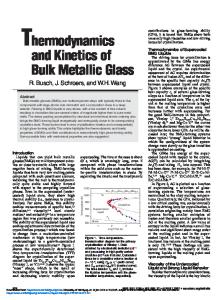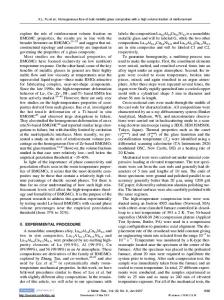Plastic flow in dynamic compression of a Zr-based bulk metallic glass
- PDF / 250,955 Bytes
- 6 Pages / 612 x 792 pts (letter) Page_size
- 66 Downloads / 351 Views
H. Choo Department of Materials Science and Engineering, The University of Tennessee, Knoxville, Tennessee 37996; and Metals and Ceramics Division, Oak Ridge National Laboratory, Oak Ridge, Tennessee 37831
P.K. Liaw Department of Materials Science and Engineering, The University of Tennessee, Knoxville, Tennessee 37996 (Received 12 January 2006; accepted 16 March 2006)
Using geometrically constrained specimens, the plastic flow behaviors of the as-cast and the relaxed Zr52.5Cu17.9Ni14.6Al10.0Ti5.0 bulk metallic glass in the dynamic compression were investigated. Both alloys exhibit a significant plasticity in the dynamic compression. The plastic deformation in both alloys is still inhomogeneous, which is characterized by the serrated plastic flow and the formation of shear bands. Free volumes affect the shear banding and the plastic flow. The reduced free volume results in the deviation of the shear banding direction from the maximum shear stress. The relaxed alloy exhibits the obvious stress overshoot, which is consistent with the theoretical prediction using a free volume model. I. INTRODUCTION
At low temperatures (e.g., room temperature) and high strain rates, metallic glasses, including bulk metallic glasses (BMGs), exhibit an inhomogeneous deformation, which is localized to narrow shear bands. The formation of the shear bands in metallic glasses affects their macroscopic plastic flow behaviors substantially and may cause premature catastrophic fracture. The inhomogeneous deformation behaviors of metallic glasses have received much attention. However, even now, there are still contradictory understandings. The inhomogeneous deformation is characterized by the serrated plastic flow and the formation of the shear bands. It was widely observed in various loading modes that with increasing strain rates, a serrated plastic flow tends to diminish.1–11 Recent research attributed this trend to the transition from the inhomogeneous to the homogenous plastic deformations at high strain rates by the simultaneous operations of numerous shear bands.1–5 Furthermore, in a deformation map of BMGs, a homogeneous deformation regime at high strain rates was proposed.3 This viewpoint is opposite to the conventional notion on the strain-rate dependence of the plastic
a)
Address all correspondence to this author. e-mail: [email protected] DOI: 10.1557/JMR.2006.0194 1570
J. Mater. Res., Vol. 21, No. 6, Jun 2006
deformation of metallic glasses.12,13 However, in their nanoindentation tests, Jiang and Atzmon11 did observe more and finer shear bands at a higher strain rate, in contrast to fewer and coarser shear bands at a lower strain rate. We note that this viewpoint is based on the work using nanoindentation, which has a different stress state from the uniaxial loading. Therefore, further investigation on this topic in a uniaxial loading is relevant. Metallic glasses are in thermodynamic metastability and their structures tend to relax by releasing the free volume. The free volume as a structural defect in the metallic glasses af
Data Loading...











